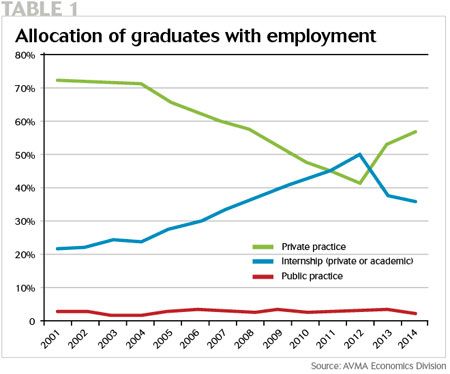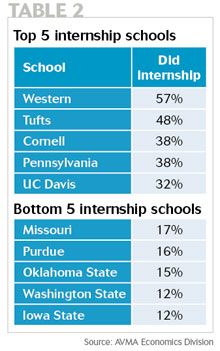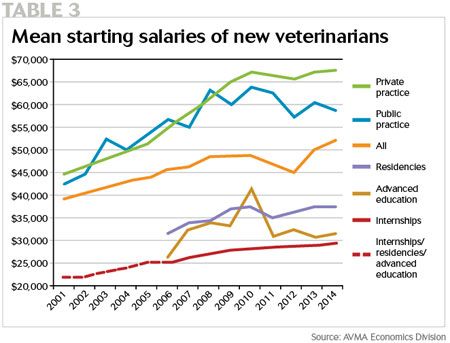Internships: A tax on new veterinarians?
Data suggest that new graduates should steer clear of internships that don't offer a clear path to advancement.
In the last decade and a half, the veterinary profession has seen some interesting trends in employment patterns, especially in the popularity of internships versus full-time employment.
In 2001, more than 70 percent of graduating seniors entered full-time employment in private practice. That declined to a low of approximately 40 percent in 2012, then returned to 56 percent in 2014. During that same time period, the percentage of students electing to complete an internship increased to mirror the decline in full-time employment. Internship selection increased from approximately 20 percent in 2001 to a high of 50 percent in 2012, then declined to 37 percent in 2014 (see Table 1).

This trend of shifting from full-time employment to internships seemed unremarkable at the time because year-to-year comparisons identified only marginal changes. Plus, the increasing percentage of students choosing internships was thought to be related to students' increased desire to be board-certified in a specialty. However, the American Veterinary Medical Association (AVMA) Veterinary Economics Division has uncovered a number of findings that cast a new light on these internships.
Four key findings
Examining unemployment and underemployment in the veterinary medical profession, two pieces of information fuel questions about internships. In our examination of unemployment and underemployment in the veterinary profession, we uncovered four pieces of information that fuel new questions about internships.
1. Internships are associated with lower perceptions of self-competence. When we evaluated veterinarians' perceptions of their own competence in the nine core veterinary competencies identified by the AVMA Council on Education (COE), no significant differences were identified we identified no significant differences between among veterinarians based on the school from which they graduated. However, we did find that veterinarians' perceptions of self-competence were significantly lower in many areas for those who had chosen internships versus those who had chosen full-time employment in a clinical practice.
2. Internships are associated with unemployment. We discovered that veterinarians who participated in internships were statistically more likely to be unemployed than those who didn't.
3. Certain schools send more students into internships. There is a significant difference among veterinary colleges in the percentage of their graduating seniors who select internships over full-time employment (see Table 2).

4. Internships cost graduates tens of thousands of dollars. The opportunity cost of an internship exceeds $40,000 when you compare the mean starting salary for full-time clinical practice with the mean starting salary for an internship. The opportunity cost includes not only the income that's given up (the difference between full-time pay and internship pay) but any added interest from student loans plus the reduced income stream caused by delaying the starting salary from a full-time position.
Internships: Cheap labor for practice owners?
In a recent study of veterinary internships, researchers noted that “although individuals who participated in internships after graduation worked more hours and earned less during their first year of employment, compared with individuals who entered clinical practice, most individuals [85 percent] who participated in internships were satisfied with their internship overall.”1 However, this study found significant differences in satisfaction between internship settings. Those who completed their internships in an academic or university setting expressed a higher level of satisfaction than those in private practice.1

Considering that the study used observations from veterinarians who participated in internships between 1995 and 2010, we can assume that the majority of these veterinarians completed their internships before 2005. This was around the time when the percentage of new veterinarians choosing internships was rapidly increasing. And with the decrease in the percentage of new veterinarians choosing internships during the past two years, there's reason to believe that the surge of internships after 2008 may have been concentrated in private practices because owners wanted to maintain profits during the sharp decline in business.
Conclusions
The facts are self-evident:
> Selecting an internship has been found to be is associated with a higher probability of unemployment.
> Veterinarians' perception of their competence in specific clinical areas is significantly different between those who select an internship and those who select private practice.
> The percentage of students who select the internship option differs significantly among veterinary colleges.
> The number of new graduates selecting internships and residencies at universities and referral practices has remained constant since 2009; the number selecting internships in private practice has increased.
> The opportunity cost of selecting an internship is greater than $40,000 per year in a profession where the mean debt-to-income ratio of 2.05-to-1 would suggest that this opportunity cost may be financially crippling for some students.
Whether taken separately or together, these facts seem to suggest that veterinary internships should be more closely examined.
Don't get me wrong-this article isn't meant to be an indictment of all internships. Instead, it's an expression of concern about what appears to be the substitution of internships for full-time private practice employment and the transfer of income from those who can least afford it (new veterinarians) to those who may least need it (practice owners).
More importantly, if the value of an internship is the mentoring the new veterinarian receives, why does it cost $40,000? Isn't mentoring (on-the-job training) a professional obligation? For this expensive mentoring to be worth it, those who complete an internship should expect to gain at least $40,000 in increased lifetime earnings when compared to those who do not, with all other things being equal.
Based on the available data, new veterinarians should steer clear of internships for now unless there's clear evidence that the selection of a specific internship provides a clear path to advancement. The best employment opportunity for new veterinarians will be with an employer who's willing to provide quality mentoring while at the same time investing in the future of the profession and paying a fair wage. Perhaps it's time for graduates to vote with their feet against this enormous tax on entering the profession.
Reference
1. Shepherd AJ, Granstrom DE, Boland LA, et al. Veterinary internship survey, 2012. JAVMA 2013; 243(7):976-980
Dr. Mike Dicks, director of the AVMA Veterinary Economics Division, holds a doctorate in agricultural economics from the University of Missouri. He has worked in Africa on water delivery and energy production technologies and served with the USDA's Economic Research Service.